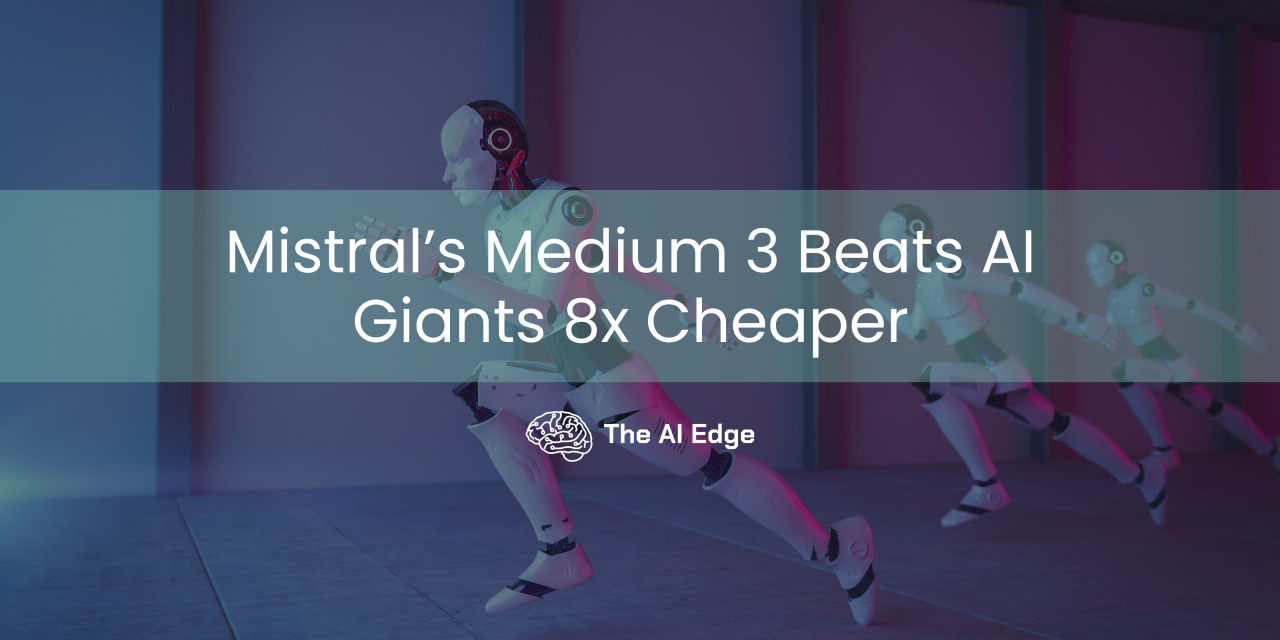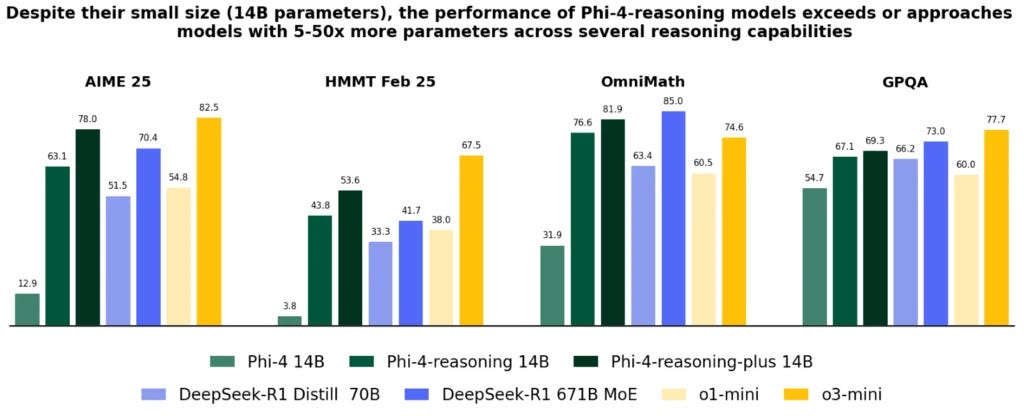Hello Engineering Leaders and AI Enthusiasts!
This newsletter brings you the latest AI updates in a crisp manner! Dive in for a quick recap of everything important that happened around AI in the past two weeks.
And a huge shoutout to our amazing readers. We appreciate you😊
In today’s edition:
🔧 Mistral challenges Big Tech with Medium 3
🗣️ Nvidia open-sources top speech AI model
🧠 Microsoft’s mini AI outsmarts big models
📚 Amazon debuts Nova Premier teacher model
➗ DeepSeek’s AI model cracks math proofs
🕸️ Sakana’s brain-like AI model learns in time
🧠 Knowledge Nugget: The many fallacies of ‘AI won’t take your job, but someone using AI will’ by
Let’s go!
Mistral challenges Big Tech with Medium 3
French AI startup Mistral has launched Medium 3, a high-performing model that goes toe-to-toe with Claude 3.7 Sonnet, GPT-4o, and Llama 4 Maverick, while costing nearly 8x less. It delivers premium performance across coding, reasoning, and general benchmarks, and is positioned as a leaner, more efficient alternative to Big Tech offerings.
Powered by Medium 3, Mistral also debuted Le Chat Enterprise, a business-focused AI assistant that integrates with tools like Google Drive and SharePoint. It helps enterprises to build custom AI agents, manage document libraries, and deploy AI across private clouds or on-premises with strict privacy controls. While Medium 3 remains closed for now, Mistral teased a possible open-source release of its larger model soon.
Why does it matter?
Mistral’s Medium 3 hits a sweet spot, competitive performance at a fraction of the cost, offering real value for enterprises optimizing AI spend. Its enterprise platform, with privacy-first deployment options, is likely to attract EU-based businesses and industries with strict data governance needs.
Nvidia open-sources top speech AI Model
Nvidia has open-sourced Parakeet V2, a powerful new speech-to-text model that can transcribe an hour of audio in just one second. Despite its compact size (600M parameters), Parakeet outperforms OpenAI’s Whisper and ElevenLabs’ Scribe, achieving a top score on the Open ASR leaderboard with a 6.05% word error rate.
Available under the permissive CC-BY-4.0 license, Parakeet V2 comes with developer-friendly features like punctuation, capitalization, timestamping, and even song-to-lyric transcription. It’s already hosted on Hugging Face, making it easy for researchers and developers to plug into real-world use cases like podcast indexing, customer call logs, or closed captioning at scale.
Why does it matter?
Nvidia isn’t just leading on the hardware front, it’s quietly becoming a major force in open AI. Parakeet V2 brings top-tier transcription to everyone, slashing dev time and cost for building accurate, real-time voice apps. Speech AI just got a lot more accessible.
Microsoft’s mini AI outsmarts big models
Microsoft just dropped three new reasoning-optimized models in its Phi family, and they punch well above their weight. The flagship Phi-4-reasoning (14B parameters) rivals DeepSeek’s 671B model on reasoning tasks, while the Phi-4-mini-reasoning (3.8B) delivers comparable math performance to 7B models, all while being small enough to run on mobile or Copilot+ PCs.
What sets these models apart is their efficiency and accessibility. All three come with open weights and permissive licenses, making them ideal for running intelligent agents on edge devices without GPU-heavy infrastructure. It’s part of Microsoft’s push to bring serious reasoning AI to more developers, faster, and without cloud dependencies.
Why does it matter?
Compact, high-reasoning models are shaping up to be the next battleground in AI. With Phi-4, Microsoft joins Mistral and Apple in targeting edge-first AI, where models don’t just fit on local devices but can reason well too. This could reshape how we build apps for phones and wearables, especially in regulated or latency-sensitive environments.
Amazon debuts Nova Premier teacher model
Amazon has launched Nova Premier, its most capable foundation model yet, designed to tackle complex workflows with multi-step reasoning, long context processing (up to 1 million tokens), and multimodal input support. It joins the Nova family on Amazon Bedrock and serves as both a general-purpose model and a “teacher” model for distilling smaller, faster variants like Nova Micro and Pro.
Nova Premier shines in agentic workflows like financial research by orchestrating multiple AI agents with task-specific roles. It also leads Amazon’s benchmark chart across 17 tests and is already being used by Slack, Robinhood, and Snorkel AI to power real-time enterprise use cases.
Why does it matter?
Amazon is pushing agentic AI into the enterprise fast lane. Nova Premier’s ability to run complex tasks and train smaller models means companies can build faster, cheaper AI workflows tailored to real business needs.
DeepSeek’s AI model cracks math proofs
Chinese lab DeepSeek just released Prover-V2, an open-source model built specifically for automated theorem proving and math problem-solving. With a massive 671B parameter architecture, the model scored 88.9% on the MiniF2F benchmark, outperforming previous systems in complex mathematical reasoning.
What makes it stand out is the hybrid approach: it first breaks down informal problems using DeepSeek-V3, then verifies the logic formally using its proof engine. The team also introduced ProverBench, a new dataset of 325 real-world math problems, including AIME and undergrad-level tasks.
Why does it matter?
It’s not R2 yet, but DeepSeek’s Prover-V2 is another quiet leap, bringing serious math power to open-source AI. It’s another step toward AI that can reason through real scientific and engineering challenges.
Sakana’s brain-like AI Model learns in time
Sakana, the Tokyo-based AI startup led by former Google Brain scientists, has introduced a new model architecture called Continuous Thought Machines (CTMs). Unlike transformers, which process all information in one fixed pass, CTMs reason step by step—adapting their “thinking time” to task complexity using neuron-level memory and self-regulated computation.
Early demos show CTMs navigating mazes, solving math sequences, and classifying images without fixed spatial cues, demonstrating both interpretability and adaptability. While not benchmark-obsessed, the model’s ability to time its internal reasoning is a bold shift toward more biologically grounded, transparent AI. The full implementation is open-source and geared toward researchers, not yet production-scale.
Why does it matter?
CTMs hint at a future beyond transformers, where AI systems don’t just respond quickly, but pause, reflect, and adapt like human cognition. It’s part of a growing shift toward time-aware, interpretable architectures that could reshape how we think about model transparency, safety, and real-world problem solving.
Enjoying the latest AI updates?
Refer your pals to subscribe to our newsletter and get exclusive access to 400+ game-changing AI tools.
When you use the referral link above or the “Share” button on any post, you’ll get the credit for any new subscribers. All you need to do is send the link via text or email or share it on social media with friends.
Knowledge Nugget: The many fallacies of ‘AI won’t take your job, but someone using AI will’
argues that the oft-quoted line “AI won’t take your job, but someone using AI will” is a classic Maginot Line fallacy: technically true yet strategically worthless. He unpacks eight systemic blind spots, from assuming task-level tweaks suffice (automation vs. augmentation) to ignoring how AI redistributes power and value across entire workflows and organizations. Rather than obsess over tool mastery, Choudary urges us to reframe our questions around how AI reshapes roles, firms, and economic logic.
By spotlighting examples from blitzkrieg tactics to containerized ports, he shows that real advantage lies in redefining systems, not merely optimizing old processes.
Why does it matter?
Strategic failure starts with asking the wrong questions. As AI reshapes how value is created and captured, the real winners will be those who rethink the system, not just their tools.
What Else Is Happening❗
🤖 Google DeepMind launches AlphaEvolve, a coding AI that evolves algorithms for math and science, boosting TPU design, data center efficiency, and solving complex problems.
📸 Mass General unveils FaceAge, an AI tool that uses facial photos to estimate biological age and improve cancer survival predictions.
🩺 OpenAI launched HealthBench, a new physician-built benchmark to test AI safety in medical chats. o3 scored 60%, GPT-3.5 just 16%.
🔍 Alibaba announced ZeroSearch, a method that cuts AI training costs by 88% by simulating search results instead of using real search engines.
🌐 OpenAI launches “OpenAI for Countries” to help nations build local AI infrastructure and deploy custom ChatGPT tools for public services.
🎨 Figma debuts AI-powered tools like Make, Sites, Draw, and Buzz to bring coding, web publishing, and marketing into its design workflow.
📹 HeyGen launches Avatar IV, an AI model that creates lifelike animated videos from a single photo and voice script, complete with gestures and expressions.
💻 Google’s Gemini 2.5 Pro I/O Edition tops AI coding leaderboards, outperforming Claude 3.7 Sonnet and OpenAI’s o3 in WebDev and LM Arena.
🍏 Apple teams up with Anthropic to bring Claude Sonnet into Xcode, testing a “vibe-coding” AI tool for automated code writing and debugging.
💳 Visa debuts Intelligent Commerce and Mastercard rolls out Agent Pay, letting AI agents shop and pay on users’ behalf with built-in safety controls.
New to the newsletter?
The AI Edge keeps engineering leaders & AI enthusiasts like you on the cutting edge of AI. From machine learning to ChatGPT to generative AI and large language models, we break down the latest AI developments and how you can apply them in your work.
Thanks for reading, and see you next week! 😊
Read More in The AI Edge







